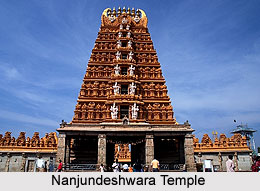 Nanjundeshwara Temple is also known as Srikanteswara. It is believed that sage Gauthama stayed here for some time and installed a Lingam. Nanjundeshwara means the God who drank poison for welfare of the world. Temple was built by the Ganga rulers in the 9th century. The residing deity was later called Hakim Nanjunda which was a name given by the Tippu Sultan. A favorite elephant of Tipu Sultan was cured after prayer was offered to the deity. This story has been inscribed in the temple. It is believed therefore that Lord Nanjundeshwara cures diseases of his devotees. The Sultan had a Lingam made of jade along with an emerald necklace and donated it to the temple. The Vaidya Nanjundeswara is considered to be a healer for his believers.
Nanjundeshwara Temple is also known as Srikanteswara. It is believed that sage Gauthama stayed here for some time and installed a Lingam. Nanjundeshwara means the God who drank poison for welfare of the world. Temple was built by the Ganga rulers in the 9th century. The residing deity was later called Hakim Nanjunda which was a name given by the Tippu Sultan. A favorite elephant of Tipu Sultan was cured after prayer was offered to the deity. This story has been inscribed in the temple. It is believed therefore that Lord Nanjundeshwara cures diseases of his devotees. The Sultan had a Lingam made of jade along with an emerald necklace and donated it to the temple. The Vaidya Nanjundeswara is considered to be a healer for his believers.
Every year thousands of worshippers gather for the famous Chariot Festival locally known as the Dodda Jathre and the Chikka Jathre. Idols of Lord Srikanteshwara, Goddess Parvathi, Lord Ganapathi, Lord Subramanya and Lord Chandikeshwara are kept in five different chariots and a puja is performed early in the morning on the Jathre day. After that chariots are flagged off. Thousands of devotees pull the Chariots carved out of wood, across the streets. Wodeyar kings have provided various grants for the temple renovation.
The entrance is in the form of a sculptured Gopura. There is a huge doorway that is fitted with wooden doors with metal decorations on it. There are detailed sculptures of different deities which are placed all around the sanctum. The passage around the sanctum has Shiva sculptures that depict him in different forms. These sculptures are made of black stone. Some of the famous forms of Shiva like: `Nataraja`, `Neelakanta`, `Ardhanareeshwara`, `Chandrashekhara`, `Umamaheshwara` have been depicted.
This article is a stub. You can enrich by adding more information to it. Send your Write Up to content@indianetzone.com





















